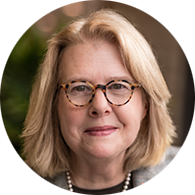
How Dana-Farber's Environment of Collaboration Sparks New Clinical Trials and Results in a Far-Reaching Impact
January 03, 2023
BRCA
Research
Susan F. Smith Center
Ovarian Cancer
By Kat J. McAlpine
Around the world, Dana-Farber's Susan F. Smith Center for Women's Cancers is known not just for its exceptional patient care, but also for the driving force its physician-scientists play in developing new paradigms of cancer treatment through pioneering research and clinical trials.
"We have an exchange of ideas all the time with colleagues all over the U.S. and internationally," says Catherine Wu, MD, chief of the Division of Stem Cell Transplantation and Cellular Therapies, who works with Susan F. Smith Center faculty and others to evaluate vaccines as cancer therapy.

In 2017, when a multi-institutional team led by Dr. Wu published a milestone paper in Nature — describing the outcomes of patients who were vaccinated with immune cells programmed to attack their high-risk melanomas — her phone started ringing off the hook. "I was contacted by reporters in Spain, Israel, Australia, England," she says. "This vaccine study — known as NeoVax for its use of neoantigens, or tumor-specific antigens — asked and answered a question: 'Can we sequence a patient's tumors, identify unique genomic mutations, and generate neoantigen vaccines that create an immune response targeting tumors in a personalized fashion?'"
Dr. Wu was senior author on the 2017 Nature paper, which was published back-to-back with a similar paper from a team in Germany.
"This research was so appealing because it addresses, head-on, the major conundrums still facing cancer science," Dr. Wu says. "Cancer is vastly heterogenous, and cancer cells constantly mutate and evolve. That means three people with the same type of breast cancer don't actually have the same exact combination of tumor mutations. That's one reason why non-personalized therapies don't always work so well, and why cancers can become resistant to treatment as certain cells evade therapy and continue to proliferate and evolve."
The 2017 study has been cited nearly 2,000 times, and remains today a first proof-of-concept for the use of personalized neoantigen vaccines in humans. A 2021 study published by Dr. Wu and collaborators in Nature Medicine found that of the eight patients with high-risk melanoma who originally received the NeoVax vaccines four years prior, all were still alive at the time of the report and six patients had no signs of active cancer.
The Ripple Effect of NeoVax

MD, PhD
Now, Dr. Wu and other Dana-Farber investigators are conducting trials to evaluate the NeoVax approach to treat renal cell carcinoma, glioblastoma, chronic lymphocytic leukemia, follicular lymphoma, and other cancers. Panagiotis Konstantinopoulos, MD, PhD, director of translational research in Gynecologic Oncology, is currently leading a team investigating NeoVax for treatment of high-grade epithelial ovarian cancers. The ongoing phase I study is evaluating the use of neoantigen vaccines in combination with nivolumab, a checkpoint inhibitor that targets a protein called PD-1, which can ward off the immune system's killer cells — known as T-cells — from attacking cancer cells.
The NeoVax study has also made waves in many other areas of science and medicine, including efforts to prevent the COVID-19 virus. "The mRNA vaccines for COVID-19 rolled out so quickly because there had already been years of efforts to develop cancer vaccines using that technology," Dr. Wu says. "Supercharging the immune system allows us to fight fire with fire. You need a complex army of soldiers to combat heterogenous diseases."
A First-Of-Its-Kind Drug Gains FDA Approval
Researchers are also looking beyond genomics, toward other biomarkers such as the specific proteins found on the surface of cancer cells, to develop new therapies for tough-to-treat cancers.

For example, patients with advanced platinum-resistant ovarian cancer currently have very limited options for treatment, says Ursula Matulonis, MD, chief of the Division of Gynecologic Oncology, and there are very few identified genomic abnormalities that can be exploited as therapeutic targets. Platinum-based doublets (a combination therapy of two drugs) are used when a patient is first diagnosed. Often, patients will develop a relapse of their cancer. When ovarian cancer returns within six months of platinum-based therapy, it is considered platinum resistant. At that point — until very recently — options approved by the U.S. Food and Drug Administration (FDA) have only been effective in few patients.
Dr. Matulonis is the principal investigator of SORAYA, an international clinical trial evaluating a first-of-its-kind antibody-drug conjugate (mirvetuximab soravtansine) designed to treat platinum-resistant, high-grade serous ovarian cancer — the most common type of ovarian cancer.
In mid-November 2022, based on the anti-cancer response and duration of the treatment efficacy, the FDA announced it had granted accelerated approval of a new option for certain patients: mirvetuximab soravtansine.
The announcement heralded a milestone — it was the first new FDA-approved therapy option for platinum-resistant ovarian cancer since 2014. The historic antibody-drug conjugate targets a protein known as folate receptor alpha, a pathway for cells to take up folate. Folate receptor alpha is overexpressed in ovarian cancers, making it a promising avenue for delivering cancer-killing payloads. The FDA's accelerated approval of mirvetuximab soravtansine is for patients with platinum resistant ovarian cancer who have received up to three prior regimens of standard treatment and whose cancer is folate receptor alpha positive.
Mirvetuximab soravtansine is comprised of an antibody (that binds to folate receptor alpha) linked to the maytansinoid drug DM4 which is toxic to cancer cells. The antibody portion of the drug delivers DM4 directly to tumor cells that are dotted with folate receptor alpha. "To overcome and bypass the lack of targetable genetic abnormalities in high-grade serous ovarian cancer, we can look instead at the expression of certain molecules covering the surfaces of tumor cells," Dr. Matulonis says.
A confirmatory phase IV clinical trial will determine if the FDA will grant continued traditional approval for use of mirvetuximab soravtansine.
Combination Therapies to Combat Platinum-Resistant Ovarian Cancer
Drs. Matulonis and Konstantinopoulos are also working together on another international study that is targeting platinum-resistant ovarian cancer. The phase III trial is comparing the combination of a PARP inhibitor (which kills tumor cells by preventing them from repairing DNA damage) and a PI3K inhibitor (which disrupts normal cellular growth and survival functions in cancers) compared to standard chemotherapy treatment. Their hope is that this PARP inhibitor and PI3K inhibitor combination will slow down the progress of cancer in platinum-resistant ovarian, fallopian tube, and peritoneal cancers more effectively than chemotherapy.
"Our gynecological group has had a longstanding interest in looking at PARP-inhibitor combination therapies," Dr. Konstantinopoulos says. The concept first arose from a Stand Up To Cancer (SU2C) Dream Team grant awarded to cancer researcher Lew Cantley, PhD, and several other collaborators. That SU2C team developed preclinical data in breast and ovarian cancers showing that inhibiting PI3K can make cancer cells more sensitive to the effect of PARP inhibitors. This work was continued by Dr. Matulonis, Dr. Konstantinopoulos, Susan F. Smith Center Director Alan D'Andrea, MD, and several collaborators in another SU2C grant that focused on ovarian cancer.
A 2019 study led by Drs. Matulonis and Konstantinopoulos, reported in Lancet Oncology, described the results of using PARP and PI3K inhibitors olaparib and alpelisib to treat patients with recurrent ovarian and breast cancers. In half of the study's patients with ovarian cancer, treatment halted disease progression.
As a result, the Dana-Farber team joined forces with Novartis, manufacturer of alpelisib, to launch EPIK-O, an international phase III randomized trial. "EPIK-O has enrolled participants at 135 clinical sites across 26 countries," Dr. Konstantinopoulos says. "We expect to have the results of the study in 2023."
Adding a Global Perspective to Strengthen Treatment Effectiveness
Susan F. Smith Center researchers are also working to improve treatment options for patients with platinum-sensitive ovarian cancer, which describes when platinum-based therapies are capable of holding off disease progression for six months or longer. Despite the efficacy, platinum-based therapies can cause significant side effects and complications.

In a Journal of Clinical Oncology paper published in July 2022, Joyce Liu, MD, MPH, and collaborators reported findings from a phase III trial (known as NRG-GY004) conducted in the U.S. and Canada, in which two platinum alternatives were evaluated: olaparib on its own or olaparib in combination with cediranib, an inhibitor that blocks blood vessel growth and is of interest to fighting cancer because of its potential to disrupt blood flow to tumors.
"In our trial, there was significant clinical activity both in terms of tumor response rate and progression-free survival in women with BRCA-mutated-ovarian cancers receiving either olaparib and/or olaparib/cediranib," says Dr. Liu, who is associate chief of Gynecologic Oncology and director of clinical research in Gynecologic Oncology. "The trial [did not] allow us to say that this activity was clearly better than standard chemotherapy; however, it [opened] the door to thinking about whether targeted combinations could be more active than chemotherapy in specific ovarian cancer populations."
Prior clinical trials had found that drugs like cediranib may cause higher rates of side effects in Japanese patients when compared to Caucasian patients. So, following the NRG-GY004 trial, Dr. Liu says another trial (NRG-GY005) opened in Japan to determine whether the combination of olaparib and cediranib can safely be given to Japanese women at the same dosages administered to Caucasian women in the U.S. and Canada.
"I think it is important to recognize that how we practice oncology treatment differs across the world, depending on resources, regulatory authorities, and many other factors," Dr. Liu says. "Differences in race and ethnicity may also have an impact on drug efficacy and safety."
International collaboration enables researchers and clinicians to generate and share more data with each other, ultimately benefiting patients. "The most challenging problems require the most teamwork, and working together with teams around the world allows us to create much more data than any one individual team could," Dr. Wu says.
International Fellows Expand Dana-Farber's Global Reach
Dana-Farber's Susan F. Smith Center for Women's Cancers welcomes many postdoctoral international fellows who conduct research, learn from clinicians, and network with other leading oncologists before returning abroad to help advance the frontier of cancer research from multiple continents.
Former fellow Romualdo Barroso-Sousa, MD, PhD, called his Dana-Farber fellowship with the Smith Center's associate director and chief of Division of Breast Oncology Sara Tolaney, MD, MPH, a "game changer" for his academic life. "The first time I got into her office and saw the number of clinical trials she was running, it was astonishing," he says. As a fellow, he worked to develop new treatment for breast cancer using immunotherapy and new biomarkers in the genome and microbiome. Today, he is a medical oncologist, head of research, and national leader in breast oncology at DASA Oncology in Brazil.
Elgene Lim, MBBS, FRACP, PhD, has taken all that he learned as a fellow — working with Myles Brown, MD, director of Dana-Farber's Center for Functional Cancer Epigenetics, and Eric Winer, MD, formerly of Dana-Farber — to the Garvan Institute of Medical Research and St. Vincent's Hospital in Australia, where he now heads the Connie Johnson Breast Cancer Research Laboratory. In addition to training in research, he also learned how to establish research ecosystems and pipelines that enable translational science, and launched a breast cancer fellowship program inspired by his Dana-Farber experience. "I still find myself channeling my Dana-Farber mentors, asking myself what they would do in challenging situations," Dr. Lim says.
Hailing from Finland, Anniina Färkkilä, MD, PhD, an oncologist and principal investigator at University of Helsinki and Helsinki University Hospital, recalls her Dana-Farber fellowship as "the most significant step" in her career. She says it "enabled a breakthrough" in her goal of becoming the independent cancer researcher and clinical oncologist that she is today. "The fellowship was the key to building international networks, learning from the best experts, and finding direction in my research," which at Dana-Farber — training alongside Susan F. Smith Center director Alan D'Andrea, MD — focused on understanding therapy resistance and identifying new therapeutic biomarkers for ovarian cancer.
Another former fellow, Shom Goel, MD, says his fellowship at Dana-Farber impacts his research daily as a clinician-scientist at the University of Melbourne and the Peter MacCallum Cancer Centre in Australia. "I share my experience at Dana-Farber with my lab team today, and this continually shapes the way we think and the way we work," he says. Working with Dana-Farber faculty researcher Jean Zhao, PhD, Dr. Goel had researched a class of drugs called cell cycle inhibitors, which led to a number of clinical trials at sites around the world. When treating his patients, Dr. Goel says he often calls on his Dana-Farber training to "deliver excellent care by seamlessly integrating the latest knowledge with deep compassion."